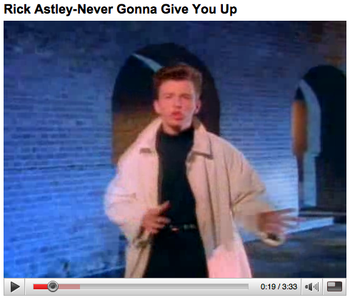 |
| Twenty years after scoring his first hit, British singer Rick Astley became an Internet phenomenon. |
According to a story in the May issue of Smithsonian magazine, memes (ideas that are spread to others) and the genetic code have several common characteristics: each meme is passed on to a new host; they can rearrange elements of their makeup; and they can evolve over time.
That observation comes from Jacques Monod, PhD, a Nobel laureate in 1965 who died 11 years later – just as the first publications were being written about ARPANET, the Internet’s predecessor. The story’s author, James Gleick, notes that this observation preceded even the DARPA-era Internet, when only a handful of academic centers were connected through a network. Noted evolutionary biologist Richard Dawkins, DPhil, picked up the theme – it was Dawkins who coined the term “meme.”
The article, which clocks in at nearly 3,950 words according to LongReads.com, is a fascinating look at where memes came from, how they’re classified and what makes them carry on as they do.
A sample, with some themes most familiar to researchers:
Like genes, memes have effects on the wide world beyond themselves. In some cases (the meme for making fire; for wearing clothes; for the resurrection of Jesus) the effects can be powerful indeed. As they broadcast their influence on the world, memes thus influence the conditions affecting their own chances of survival. The meme or memes comprising Morse code had strong positive feedback effects …
Perhaps the analogy with disease was inevitable. Before anyone understood anything of epidemiology, its language was applied to species of information. An emotion can be infectious, a tune catchy, a habit contagious. “From look to look, contagious through the crowd / The panic runs,” wrote the poet James Thomson in 1730. Lust, likewise, according to Milton: “Eve, whose eye darted contagious fire.” But only in the new millennium, in the time of global electronic transmission, has the identification become second nature. Ours is the age of virality: viral education, viral marketing, viral e-mail and video and networking. Researchers studying the Internet itself as a medium—crowdsourcing, collective attention, social networking and resource allocation—employ not only the language but also the mathematical principles of epidemiology.Indeed, in the communication age, information needs seconds to travel globally. Contrast that with one of Gleick’s examples, Sir Isaac Newton. Despite being one of the most famous men in England in his day, only a few thousand people had any idea what he looked like. Today, people around the world recognize the likeness of President Barack Obama or basketball player LeBron James.
Gleick also cites “jumping the shark” as another example; in the days of digital communication, there are boundless others: Rickrolling, “all your base are belong to us,” Cigar Guy and a Coke geyser – all being continually updated, passed on and giving way to the latest sensation.
Special thanks to today's guest blogger, Brian Hunsicker, a communications specialist at Research!America. Prior to his position at Research!America, Brian was a sportswriter and copy editor at The News & Messenger in Woodbridge, Virginia.

No comments:
Post a Comment